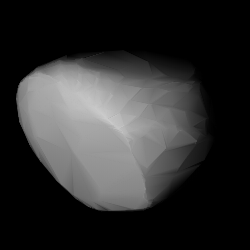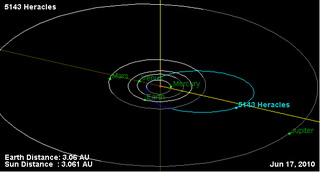
1036 Ganymed, provisional designation 1924 TD, is a stony asteroid on a highly eccentric orbit, classified as a near-Earth object of the Amor group. It was discovered by German astronomer Walter Baade at the Bergedorf Observatory in Hamburg on 23 October 1924, and named after Ganymede from Greek mythology. With a diameter of approximately 35 kilometers, Ganymed is the largest of all near-Earth objects but does not cross Earth's orbit. The S-type asteroid has a rotation period of 10.3 hours. In October 2024, it is predicted to approach Earth at a distance of 56,000,000 km; 35,000,000 mi (0.374097 AU).

4183 Cuno, provisional designation 1959 LM, is an eccentric, rare-type asteroid, classified as near-Earth object and potentially hazardous asteroid of the Apollo group, and measures approximately 4 kilometers in diameter.
4486 Mithra, is an eccentric asteroid and suspected contact-binary, classified as near-Earth object and potentially hazardous asteroid, approximately 2 kilometers in diameter. It belongs to the Apollo group of asteroids and is a relatively slow rotator.

2062 Aten, provisional designation 1976 AA, is a stony sub-kilometer asteroid and namesake of the Aten asteroids, a subgroup of near-Earth objects. The asteroid was named after Aten from Egyptian mythology.
5653 Camarillo ( KAM-ə-REE-oh), provisional designation 1992 WD5, is a stony asteroid and near-Earth object of the Amor group, approximately 1.5 kilometers in diameter.

3752 Camillo is an inclined contact-binary asteroid, classified as near-Earth object of the Apollo group, approximately 2.3 kilometers in diameter. It was discovered on 15 August 1985, by astronomers Eleanor Helin and Maria Barucci using a 0.9-metre (35 in) telescope at the CERGA Observatory in Caussols, France. Lightcurve studies by Petr Pravec in 1998 suggest that the assumed S-type asteroid has an elongated shape and a longer-than average rotation period of 38 hours.

3122 Florence is a stony trinary asteroid of the Amor group. It is classified as a near-Earth object and potentially hazardous asteroid. It measures approximately 5 kilometers in diameter. It orbits the Sun at a distance of 1.0–2.5 AU once every 2 years and 4 months ; the orbit has an eccentricity of 0.42 and an inclination of 22° with respect to the ecliptic. Florence has two moons.

5143 Heracles, provisional designation 1991 VL, is a highly eccentric, rare-type asteroid and synchronous binary system, classified as near-Earth object of the Apollo group, approximately 4.8 kilometers in diameter. The asteroid was discovered on 7 November 1991, by American astronomer Carolyn Shoemaker at Palomar Observatory in California, United States. It is named for the Greek divine hero Heracles. It has an Earth minimum orbit intersection distance of 0.058 AU (8.7 million km) and is associated with the Beta Taurids daytime meteor shower.
4055 Magellan, provisional designation 1985 DO2, is a bright and eccentric asteroid and near-Earth object of the Amor group, approximately 2.5 kilometers in diameter. It was discovered on 24 February 1985, by American astronomer Eleanor Helin at Palomar Observatory in California, United States. It was later named for Portuguese explorer Ferdinand Magellan.
11066 Sigurd, provisional designation 1992 CC1, is a stony, rare-type asteroid and elongated contact binary, classified as near-Earth object of the Apollo group of asteroids, approximately 2.5 kilometers in diameter.
12923 Zephyr (prov. designation:1999 GK4) is a stony asteroid, classified as potentially hazardous asteroid and near-Earth object of the Apollo group, approximately 2 kilometers (1.2 miles) in diameter. It was discovered on 11 April 1999, by astronomers of the Lowell Observatory Near-Earth Object Search at Anderson Mesa Station near Flagstaff, Arizona. The asteroid was named after the deity Zephyrus from Greek mythology.
(5645) 1990 SP is an eccentric and tumbling asteroid, classified as near-Earth object of the Apollo group, approximately 1.7 kilometers in diameter. It was discovered on 20 September 1990, by Scottish–Australian astronomer Robert McNaught at the Siding Spring Observatory in Canberra, Australia. Scientists have said that it has a '1 in 364 billion chance' of colliding with the Earth.
(5646) 1990 TR is a probable rare-type binary asteroid classified as near-Earth object of the Amor group, approximately 2.3 kilometers in diameter. It was discovered on 11 October 1990, by Japanese astronomers Seiji Ueda and Hiroshi Kaneda at Kushiro Observatory near Kushiro, in eastern Hokkaido, Japan.
(8201) 1994 AH2 is a highly eccentric, rare-type asteroid, classified as near-Earth object of the Apollo group of asteroids, approximately 2 kilometers in diameter. It was discovered on 5 January 1994, by Australian amateur astronomer Gordon Garradd during the AANEAS survey at the Siding Spring Observatory, Australia. It has an Earth minimum orbit intersection distance of 0.1 AU (15 million km) and is associated with the Beta Taurids daytime meteor shower.
(394130) 2006 HY51 is a near-Earth object of the Apollo asteroid group with a high orbital eccentricity, approximately 1.2 kilometers in diameter. It was discovered on 26 April 2006, by LINEAR at Lincoln Lab's ETS in Socorro, New Mexico, United States.
21088 Chelyabinsk, provisional designation 1992 BL2, is a stony asteroid and near-Earth object of the Amor group, approximately 4 kilometers in diameter. It was discovered on 30 January 1992, by Belgian astronomer Eric Elst at ESO's La Silla Observatory in northern Chile. The asteroid was named after the Russian city of Chelyabinsk and for its spectacular Chelyabinsk meteor event in 2013.
(85713) 1998 SS49, provisional designation 1998 SS49, is an asteroid on an eccentric orbit, classified as near-Earth object and potentially hazardous asteroid of the Apollo group, approximately 3 kilometers (1.9 miles) in diameter. The asteroid was discovered on 29 September 1998, by astronomers of the LINEAR program at Lincoln Laboratory's Experimental Test Site near Socorro, New Mexico, in the United States. It is one of the largest potentially hazardous asteroids and has a notably low Earth-MOID of less than the distance to the Moon.
(163243) 2002 FB3, provisional designation 2002 FB3, is a stony asteroid on an eccentric orbit, classified as near-Earth object and potentially hazardous asteroid of the Athen group, approximately 1.6 kilometers (1 mile) in diameter. It was discovered on 18 March 2002, by astronomers with the Lincoln Near-Earth Asteroid Research at the Lincoln Laboratory's Experimental Test Site near Socorro, New Mexico, in the United States. The Q-type asteroid has a rotation period of 6.2 hours.

(164121) 2003 YT1, provisional designation 2003 YT1, is a bright asteroid and synchronous binary system on a highly eccentric orbit, classified as near-Earth object and potentially hazardous asteroid of the Apollo group, approximately 2 kilometers (1.2 miles) in diameter. It was discovered on 18 December 2003, by astronomers with the Catalina Sky Survey at the Catalina Station near Tucson, Arizona, in the United States. The V-type asteroid has a short rotation period of 2.3 hours. Its 210-meter sized minor-planet moon was discovered at Arecibo Observatory in May 2004.









